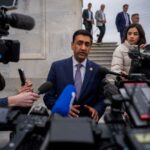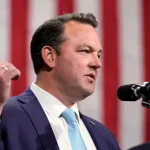
Former CIA Deputy Director Mike Morrell warned in a recent op-ed of the terror threat posed by vulnerabilities at the U.S.-Mexico border.
“Given the particular vulnerability of the southern border, Biden’s recent executive order to restrict asylum processing is a valuable step toward limiting entry to the United States,” Morell and Graham Allison, former United States Assistant Secretary of Defense for Policy and Plans, wrote in an op-ed published by Foreign Affairs on June 10.
“But with U.S. Customs and Border Protection reporting close to 200,000 encounters with migrants at this border each month so far in 2024, and with thousands of people each week crossing the border undetected, the government will need to take additional action — including the use of national emergency authorities — to ensure that terrorists are not exploiting this overwhelmed channel to enter the country,” they said.
The op-ed notes how FBI Director Christopher Wray in at least eight appearances before Congress since last fall — including one just earlier this month — identified three different categories of threats to the U.S. homeland: international terrorism, domestic terrorism and state-sponsored terrorism. In December, Wray told the Senate Judiciary Committee all three are “simultaneously elevated.”
In speaking about the already heightened threat environment worsening since Hamas terrorists attacked southern Israel on Oct. 7, “Wray has repeatedly drawn attention to security gaps at the United States’ southern border, where thousands of people each week enter the country undetected,” Morell and Graham noted.
“Last year, hundreds of individuals on the United States’ terrorist watch list attempted to enter the country via the southern border,” Morell and Allison wrote. “It is not difficult to imagine a person, or even a group, with the intent to do harm slipping across a border—where U.S. officials reported 2.5 million encounters with migrants in 2023—and then purchasing assault rifles and carrying out a large massacre. There is no shortage of locations across the United States where hundreds, if not thousands, of people gather on a regular basis—and all may be ready targets for those seeking to incite terror.”
The op-ed said that “stated intentions of terrorist groups, the growing capabilities they have demonstrated in recent successful and failed attacks around the world, and the fact that several serious plots in the United States have been foiled point to an uncomfortable but unavoidable conclusion.”
“Put simply, the United States faces a serious threat of a terrorist attack in the months ahead,” Morell and Allison added.
In addition to Wray’s warnings, the op-ed notes how United States Central Command (CENTCOM) commander General Erik Kurilla has been sounding alarms regarding terror groups his forces are fighting in the Middle East, especially since the Biden administration pulled U.S. forces out of Afghanistan. Kurilla has called particular attention to ISIS-K, the ISIS affiliate in Afghanistan and Pakistan.
Earlier this year, ISIS-K mounted the deadliest terror attack Iran had experienced since the founding of the Islamic Republic, in which two suicide bombers killed at least 95 people at a memorial on the anniversary of the death of senior Iranian military official Qasem Soleimani, who was killed in a January 2020 operation by U.S. forces.
FORMER ASSISTANT FBI DIRECTOR WARNS AGAINST ‘HUGE VULNERABILITY’ ASSOCIATED WITH BORDER SURGE
ISIS-K struck again in March, “when four terrorists killed 145 people and injured 550 more in a brazen attack on a concert hall in Moscow,” Morell and Allison wrote.
The op-ed says foiled terror plots in the United States in recent years should be the “ultimate wake-up call.”
In April 2022, the Justice Department charged an Iranian government official based in Tehran with attempting to hire a hit man to assassinate former U.S. National Security Adviser John Bolton. The next month, the FBI reported “that it had thwarted the plans of an Iraqi national living in Ohio to smuggle four people across the southern border to assassinate former President George W. Bush,” the piece says.
The FBI also recently shared declassified intelligence with Politico showing that the agency had stopped a plot to attack critical infrastructure in the United States last fall.
“[T]he FBI director’s and the CENTCOM commander’s statements almost certainly reflect the classified intelligence they are reading and the law enforcement and military operations in which their organizations are involved,” the op-ed says. “Their words should be taken seriously.”
Morell and Allison also urged Washington to consider “something otherwise unthinkable: work with the Taliban,” floating potential limited intelligence exchanges to target ISIS-K militants overseas.
“Taking these steps would be difficult in the best of times, let alone ahead of an election. But terrorists can strike without warning, and they feel no need to respect the U.S. political calendar,” Morell and Allison wrote. “For the past two decades, under both Republican and Democratic administrations, the efforts of thousands of Americans in the military and intelligence communities have spared the country a second 9/11—or worse. This is an extraordinary achievement, but the work is not done. A terrorist attack is a preventable catastrophe. As the threat increases, policymakers must rise to the challenge to protect the U.S. homeland.”









